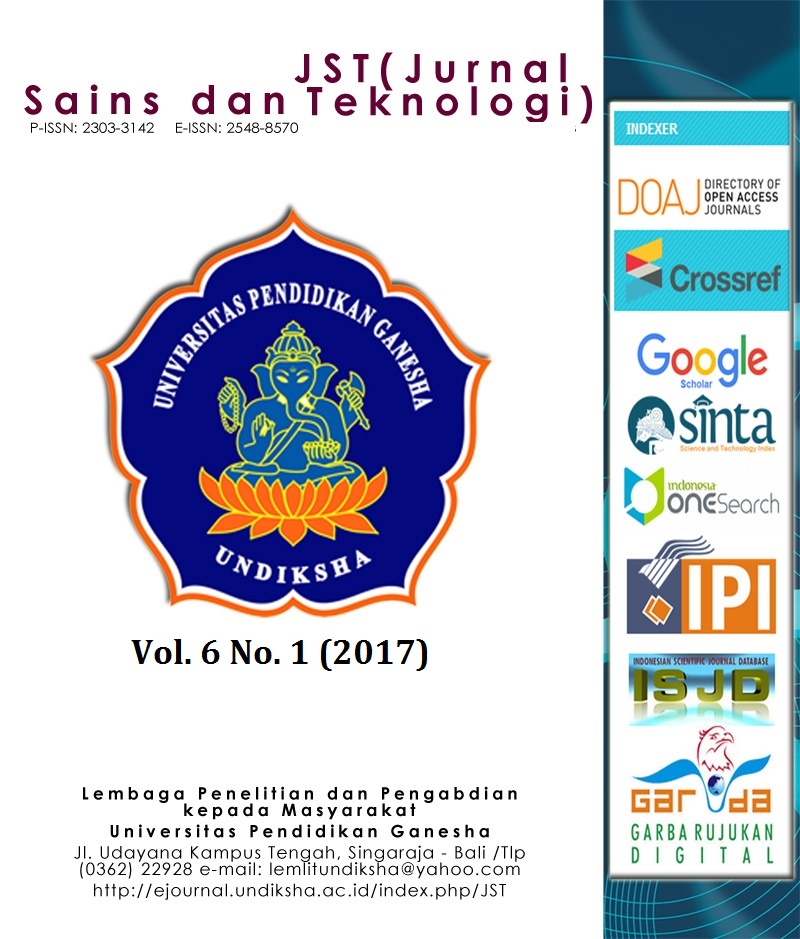APLIKASI HUMIN PADA PROSES ADSORPSI REDUKTIF AuCl₄ˉ DI BAWAH PENGARUH SINAR UV
DOI:
https://doi.org/10.23887/jstundiksha.v6i1.9306Kata Kunci:
term1Abstrak
Telah dilakukan proses adsorpsi reduktif larutan AuCl₄ˉ menggunakan humin di bawah pengaruh sinar UV. Humin diisolasi dari tanah gambut Kalimantan Selatan, Indonesia, menggunakan metode yang diadopsi dari International Humic substances Society (IHSS). Hasil karakterisasi menunjukkan humin isolasi memiliki kandungan –COOH dan –OH fenolat yang bertanggung jawab dalam proses adsorpsi dan reduksi AuCl₄ˉ menjadi Au. Kondisi optimum reaksi diperoleh pada pH 2 dengan waktu interaksi selama 900 menit di bawah sinar UV, waktu ini lebih cepat dibandingkan interaksi pada kondisi gelap. Kinetika adsorpsi mengikuti model kinetika pseudo orde dua. Sedangkan model isoterm adsorpsi mengikuti model isoterm Langmuir dengan kapasitas adsorpsi sebesar 83,33 mg/g. Kemampuan humin dalam mereduksi AuCl₄ˉ ditunjukkan dengan keberadaan puncak karakteristik logam Au pada difraktogram humin setelah proses adsorpsiReferensi
An, F.-Q., Li, M., Guo, X.-D., Wang, H.-Y., Wu, R.-Y., Hu, T.-P., . . . Jiao, W.-Z. (2017). Selective adsorption of AuCl4− on chemically modified D301 resin with containing N/S functional polymer. Journal of Environmental Chemical Engineering, 5(1), 10-15. doi:http://dx.doi.org/10.1016/j.jece.2016.11.010
Andreas, R., & Zhang, J. (2014). Characteristics of Adsorption Interactions of Cadmium(II) onto Humin from Peat Soil in Freshwater and Seawater Media. Bulletin of Environmental Contamination and Toxicology, 92(3), 352-357. doi:10.1007/s00128-014-1205-x
Birloaga, I., De Michelis, I., Ferella, F., Buzatu, M., & Vegliò, F. (2013). Study on the influence of various factors in the hydrometallurgical processing of waste printed circuit boards for copper and gold recovery. Waste Management, 33(4), 935-941. doi:http://dx.doi.org/10.1016/j.wasman.2013.01.003
Choi, C., & Hu, N. (2013). The modeling of gold recovery from tetrachloroaurate wastewater using a microbial fuel cell. Bioresource Technology, 133, 589-598. doi:http://dx.doi.org/10.1016/j.biortech.2013.01.143
Dwivedi, A. D., Dubey, S. P., Hokkanen, S., Fallah, R. N., & Sillanpää, M. (2014). Recovery of gold from aqueous solutions by taurine modified cellulose: An adsorptive–reduction pathway. Chemical Engineering Journal, 255, 97-106. doi:http://dx.doi.org/10.1016/j.cej.2014.06.017
Fan, R., Xie, F., Guan, X., Zhang, Q., & Luo, Z. (2014). Selective adsorption and recovery of Au(III) from three kinds of acidic systems by persimmon residual based bio-sorbent: A method for gold recycling from e-wastes. Bioresource Technology, 163, 167-171. doi:http://dx.doi.org/10.1016/j.biortech.2014.03.164
Jesus, A. M. D., Romão, L. P. C., Araújo, B. R., Costa, A. S., & Marques, J. J. (2011). Use of humin as an alternative material for adsorption/desorption of reactive dyes. Desalination, 274(1–3), 13-21. doi:http://dx.doi.org/10.1016/j.desal.2011.01.063
Li, C. L., Wang, S., Ji, F., Zhang, J. J., & Wang, L. C. (2015). Thermodynamics ofCu2+Adsorption on soilHumin. International Journal of Environmental Research, 9(1), 43-52. Retrieved from http://ijer.ut.ac.ir/article_872.html
Pacławski, K., & Fitzner, K. (2004). Kinetics of gold(III) chloride complex reduction using sulfur(IV). Metallurgical and Materials Transactions B, 35(6), 1071-1085. doi:10.1007/s11663-004-0063-z
Santosa, S. J., Sudiono, S., Siswanta, D., Kunarti, E. S., & Dewi, S. R. (2011). Mechanism of the Removal of AuCl−4 Ions from Aqueous Solution by Means of Peat Soil Humin. Adsorption Science & Technology, 29(8), 733-746. doi:10.1260/0263-6174.29.8.733
Unduhan
Diterbitkan
Cara Mengutip
Terbitan
Bagian
Lisensi
Authors who publish with the Jurnal Sains dan Teknologi (JST) agree to the following terms:
- Authors retain copyright and grant the journal the right of first publication with the work simultaneously licensed under a Creative Commons Attribution License (CC BY-SA 4.0) that allows others to share the work with an acknowledgment of the work's authorship and initial publication in this journal.
- Authors are able to enter into separate, additional contractual arrangements for the non-exclusive distribution of the journal's published version of the work (e.g., post it to an institutional repository or publish it in a book), with an acknowledgment of its initial publication in this journal.
- Authors are permitted and encouraged to post their work online (e.g., in institutional repositories or on their website) prior to and during the submission process, as it can lead to productive exchanges, as well as earlier and greater citation of published work. (See The Effect of Open Access)
















